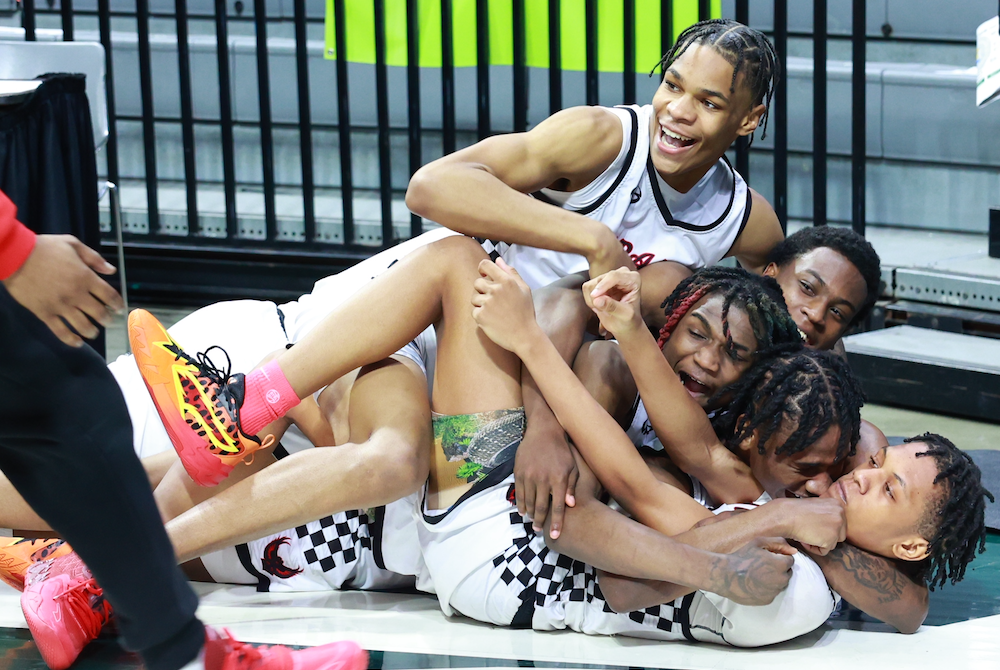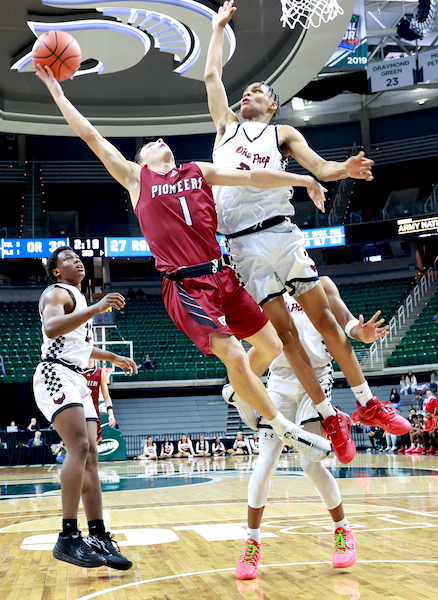
MHSA(Q&)A: Historian Ron Pesch
April 16, 2012
 When we receive a question on the history of MHSAA athletics that we can't answer on the spot, Muskegon's Ron Pesch is the first person we seek out for help.
When we receive a question on the history of MHSAA athletics that we can't answer on the spot, Muskegon's Ron Pesch is the first person we seek out for help.
Pesch took the reins as Michigan's chief high school sports historian during the mid 1990s after the retirement of legendary MHSAA record book originator Dick Kishpaugh and has contributed to various efforts and publications across the state.
One of his latest projects is the awarding of "retro" Mr. Basketball Awards. The first Hal Schram Mr. Basketball Award was given by the Basketball Coaches Association of Michigan in 1981 to Lansing Eastern's Sam Vincent. Three seasons ago, BCAM -- with research work by Pesch -- began awarding retro winners for the previous decades beginning with the 1920s. This winter, BCAM honored retro winners from 1922, 1932, 1942, 1952, 1962 and 1972.
Click to read more about those winners and the finalists recognized last month. Also, click for links to the previous retro winners. The retro Mr. Basketball project will last seven more seasons. Pesch explains more below.
How did you come up with rewarding a “Retro” Mr. Basketball?
The project came out of a conversation I had with (BCAM executive director) Tom Hursey at the basketball finals back in '99. Together, we hatched an approach honoring the state's past basketball greats. He let me run with it, while he worked on getting a subcommittee launched to make the selection.
How do you dig up all of this nomination info?
Between votes, I work on digging out the details. My initial target list always begins with all-state teams - if, of course they exist. All-tournament teams for the early years also serve as a starting point -- if they exist. Best I can tell, the Detroit Times, the Free Press and the News have all named all-state squads, at various points, back to about 1935. The Associated Press and UPI came to the game much later - somewhere around the early to mid 1960s. I then work on creating a crosstab on the players selected, noting the "teams" on which they were named (Class A 1st team, Dream Team, Class C 3rd team), and try to find quotes detailing their games. The result is really a reflection of the times and the history of newspaper reporting.
In early years, we can struggle to uncover a player’s first name, let alone his class in school. And statistical coverage of a player's abilities was very limited. It's simply the way things were back then. Everyone in town knew King Lewis, or Red Cherry, or Young Jacks. And the final box score only contained points, fouls, substitutions, as they were all you really needed to know about the game. But by visiting the state library in Lansing, and looking at a cross-section of newspapers, you can usually dig out what you need.
Do you collect from other sources as well?
Another source is high school yearbooks. Some resources have started to emerge online. I also tap into the MHSAA site and make contact with ADs around the state, asking for their assistance on digging out details - especially class in school. Like the current program, only "seniors" are considered for the award. Mid-year graduates can create a challenge, but the rule currently in place is a player is considered a nominee in the year in which he was last eligible for the state tournament. In other words, if you graduated in January or February of 1943, you would be considered for the 1942 ballot. It appears that a similar approach was used in selecting all-state teams.
|
Year |
Player |
High School |
Age |
Height |
Weight |
Year |
DFP |
DN |
DT |
AP |
UPI |
Tourney |
|
1971 A-1 G. |
Frank Tanana, Jr. (C) |
Detroit Catholic Central |
17 |
6-3 |
170 |
Sr. |
A1 |
A1 |
A1 |
A1 |
||
|
1971 A-1 C |
Tom McGill |
Flint Northern |
17 |
6-3 |
190 |
Sr. |
A1 |
DM |
A1 |
A1 |
||
|
1971 A-1 F. |
Lindsay Hairston |
Detroit Kettering |
17 |
6-9 |
203 |
Sr. |
A1 |
DM |
A1 |
A1 |
||
|
1971 A-1 F. |
Campy Russell |
Pontiac Central |
18 |
6-7 |
190 |
Sr. |
A1 |
DM |
A1 |
A1 |
That cross-tab table will help establish a list of nominees. A consensus first-team pick is an obvious candidate. When only a single all-state team is available, I'll do what I can to look up all-conference teams or all-area teams from around the state to see who else might be considered. While life after high school is not a considered when trying to pick a winner, a player who emerges as a star in college or in the pros may emerge as a candidate when you see his details in a local paper.
Bios are assembled from the newspaper reports, detailing as much as we can find on high school player's career. I'll tap into a variety of resources including old team histories when available. When needed, I'll toss out request to reporters, old and new, around the state. Local librarians and historians are another wonderful resource.
How does voting work?
Between sessions of the Boys Finals, the committee assembles to hash out a final ballot, and to make a selection. I don't vote, but I may guide the conversation and provide any additional details when needed, reminding members that we're focusing on their high school careers. The process is certainly imperfect. But the committee approach prevents the process from becoming a popularity contest. These guys have the benefit of watching many of the players play. And, like the current Mr. Basketball program, they sometimes surprise. But that's what makes it fun. And, of course, stirs the pot. It gets people talking about the history of basketball in this state.
Is there a theme to MHSAA basketball that has remained constant over the years?
For me the greatest thing about the basketball tournament is that it assembles a wide range of folks who want to see players they've heard about in action. And the process, for the most part, hasn't change since the 1920s. While the style of the game has changed, winning a title is much the same as it was back when our great-grandfathers played: You gotta get through the tournament. And only four trophies are awarded.
These guys were the "Magic" of their day. I'm hoping we never forget that.

Boyd Finds Nothing but Net as Old Redford Earns Championship Day Debut
By
Keith Dunlap
Special for MHSAA.com
March 14, 2024
EAST LANSING — The day before his team’s Division 3 Semifinal against Riverview Gabriel Richard, Detroit Old Redford head coach Ray Reeves said he installed a new play for his team to run.
Lo and behold, Old Redford found itself running that play Thursday at its most important moment of the season.
The Ravens were trailing by a point with two seconds remaining in regulation and set to inbound the ball from underneath their basket.
The play was called “one,” mainly because it was one of five new plays Reeves said were installed.
“I was watching Auburn play and I saw (head coach) Bruce Pearl run it,” Reeves said. “I took it from him.”
That play ended up earning Old Redford a chance to finish this season “one” in the state, as senior Justin Austin inbounded the ball into the near corner on the left side of the floor to junior Arkell Boyd, who drained a heavily-contested 3-pointer just before the buzzer to give the Ravens a 43-41 win over Gabriel Richard.
Old Redford will meet Niles Brandywine at 4:30 p.m. Saturday in a matchup of teams making their first appearance in an MHSAA Final in this sport.
 “When that particular play came at the end of the game, I knew what to do,” said Boyd, who was mobbed by teammates on the floor after the shot went in.
“When that particular play came at the end of the game, I knew what to do,” said Boyd, who was mobbed by teammates on the floor after the shot went in.
The win continued a magical journey for Old Redford, which earned a one-point win over 2023 champion Flint Beecher in the Quarterfinal and a two-point victory over Detroit Loyola in a Regional Final.
Expanding on his team’s run this season, Reeves said the pivotal moment came during a trip to Indiana earlier in the year that produced some roster attrition.
“We went to Indiana with 14 players and came back with nine,” Reeves said.
The roster cut came after what Reeves said were issues with overbearing parents, which he said produced a team meeting that lasted from 10 p.m. until roughly 7 a.m. the next morning in Indiana.
“We knew it had to change,” Reeves said. “You think as an adult it would sometimes get better because you are dealing with adults. But I realized it was getting worse and it was killing my team. We came together that night, and we haven’t looked back.”
Trailing 37-32 with 4:42 remaining, Gabriel Richard mounted a charge, going on a 7-0 run to take a 39-37 lead with 2:01 left following a 3-point play by junior Nick Sobush.
Old Redford tied the game at 39-39 with 33.8 seconds remaining on a steal and layup by junior Kason Mayes, but Gabriel Richard regained the lead at 41-39 with 14.3 seconds left with a layup by junior Luke Westerdale.
Following a timeout, Old Redford put the ball in the hands of Mayes, who was fouled on a layup attempt with 3.3 seconds to go.
Mayes made the first free throw and missed the second to make it 41-40 Gabriel Richard. But Old Redford got the ball back when the rebound went off a Gabriel Richard player, which set up Boyd’s heroics.
Mayes scored 16 points, and Boyd added 15 for Old Redford (21-7).
Junior Charles Kage had 15 points and nine rebounds, and Sobush added 13 points for Gabriel Richard (23-4).
“It’s tough to swallow,” Gabriel Richard head coach Kris Daiek said. “I thought our kids played hard. But hey, it happens. It’s March Madness.”
The good news for Gabriel Richard is that all six players who saw minutes Thursday are expected back to help the program expand on what was its first Semifinal appearance since 1989.
“This is an educational moment for my kids,” Daiek said. “It stinks now. I give credit to Old Redford. It was a great battle all the way down the stretch. This will build character and make us a little bit tougher.”
PHOTOS (Top) Teammates pile onto Detroit Old Redford’s Arkell Boyd after his game-winning basket Thursday at Breslin Center. (Middle) The Ravens’ Ja'Quan Stennis gets a hand up high as Gabriel Richard’s Nick Sobush (1) works to get off a shot. (Photos by Hockey Weekly Action Photos.)

